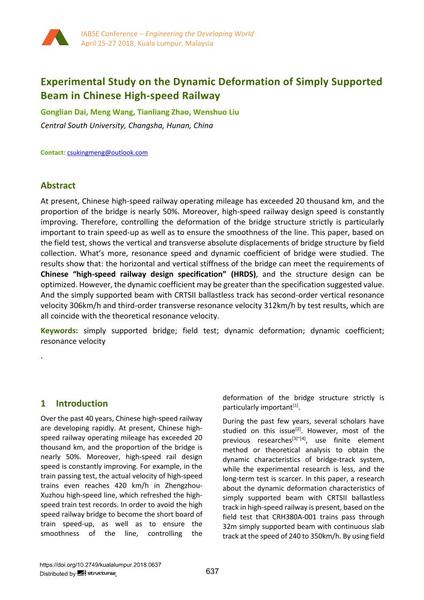Experimental Study on the Dynamic Deformation of Simply Supported Beam in Chinese High-speed Railway

|
|
|||||||||||
Bibliographic Details
| Author(s): |
Gonglian Dai
(Central South University, Changsha, Hunan, China)
Meng Wang (Central South University, Changsha, Hunan, China) Tianliang Zhao (Central South University, Changsha, Hunan, China) Wenshuo Liu (Central South University, Changsha, Hunan, China) |
||||
|---|---|---|---|---|---|
| Medium: | conference paper | ||||
| Language(s): | English | ||||
| Conference: | IABSE Conference: Engineering the Developing World, Kuala Lumpur, Malaysia, 25-27 April 2018 | ||||
| Published in: | IABSE Conference Kuala Lumpur 2018 | ||||
|
|||||
| Page(s): | 637-643 | ||||
| Total no. of pages: | 7 | ||||
| DOI: | 10.2749/kualalumpur.2018.0637 | ||||
| Abstract: |
At present, Chinese high-speed railway operating mileage has exceeded 20 thousand km, and the proportion of the bridge is nearly 50%. Moreover, high-speed railway design speed is constantly improving. Therefore, controlling the deformation of the bridge structure strictly is particularly important to train speed-up as well as to ensure the smoothness of the line. This paper, based on the field test, shows the vertical and transverse absolute displacements of bridge structure by field collection. What’s more, resonance speed and dynamic coefficient of bridge were studied. The results show that: the horizontal and vertical stiffness of the bridge can meet the requirements ofChinese “high-speed railway design specification” (HRDS), and the structure design can be optimized. However, the dynamic coefficient may be greater than the specification suggested value. And the simply supported beam with CRTSII ballastless track has second-order vertical resonance velocity 306km/h and third-order transverse resonance velocity 312km/h by test results, which are all coincide with the theoretical resonance velocity. |
||||
| Keywords: |
field test simply supported bridge dynamic deformation dynamic coefficient resonance velocity
|
||||
